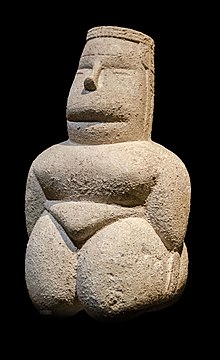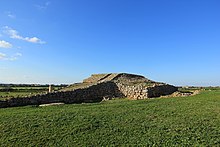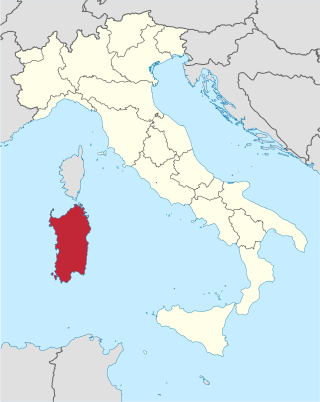
Sardinia is the second-largest island in the Mediterranean Sea, after Sicily, and one of the twenty regions of Italy. It is located west of the Italian Peninsula, north of Tunisia and immediately south of the French island of Corsica.

Archaeological evidence of prehistoric human settlement on the island of Sardinia is present in the form of nuraghes and other prehistoric monuments, which dot the land. The recorded history of Sardinia begins with its contacts with the various people who sought to dominate western Mediterranean trade in classical antiquity: Phoenicians, Punics and Romans. Initially under the political and economic alliance with the Phoenician cities, it was partly conquered by Carthage in the late 6th century BC and then entirely by Rome after the First Punic War. The island was included for centuries in the Roman province of Sardinia and Corsica, which would be incorporated into the diocese of Italia suburbicaria in 3rd and 7th centuries.

The Sherden are one of the several ethnic groups the Sea Peoples were said to be composed of, appearing in fragmentary historical and iconographic records from the Eastern Mediterranean in the late 2nd millennium BC.

Domus de Janas are a type of pre-Nuragic rock-cut chamber tomb found in Sardinia. They consist of several chambers quarried out by the people of the San Ciriaco through Ozieri cultures and subsequent cultures, resembling houses in their layout.

The Province of Sardinia and Corsica was an ancient Roman province including the islands of Sardinia and Corsica.

Su Nuraxi is a nuragic archaeological site in Barumini, Sardinia, Italy. Su Nuraxi simply means "The Nuraghe" in Campidanese, the southern variant of the Sardinian language.

The Nuragic civilization, also known as the Nuragic culture, was a civilization or culture on the Mediterranean island of Sardinia, Italy, which lasted from the 18th century BC, or from the 23rd century BC, up to the Roman colonization in 238 BC. Others date the culture as lasting at least until the 2nd century AD, and in some areas, namely the Barbagia, to the 6th century AD, or possibly even to the 11th century AD.

Monte d'Accoddi is a Neolithic archaeological site in northern Sardinia, located in the territory of Sassari. The site consists of a massive raised stone platform thought to have been an altar. It was constructed by the Ozieri culture or earlier, with the oldest parts dated to around 4,000–3,650 BC.

The Bonnanaro culture is a protohistoric culture that flourished in Sardinia during the 2nd millennium BC, considered to be the first stage of the Nuragic civilization. It takes its name from the comune of Bonnanaro in the province of Sassari where in 1889 the eponymous site was discovered.

The Sardinians, or Sards, are a Romance language-speaking ethnic group native to Sardinia, from which the western Mediterranean island and autonomous region of Italy derives its name.
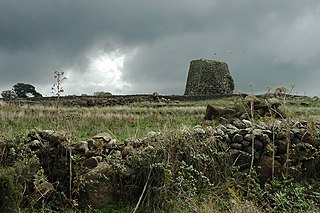
Paleo-Sardinian, also known as Proto-Sardinian or Nuragic, is an extinct language, or perhaps set of languages, spoken on the Mediterranean island of Sardinia by the ancient Sardinian population during the Nuragic era. Starting from the Roman conquest with the establishment of a specific province, a process of language shift took place, wherein Latin came slowly to be the only language spoken by the islanders. Paleo-Sardinian is thought to have left traces in the island's onomastics as well as toponyms, which appear to preserve grammatical suffixes, and a number of words in the modern Sardinian language.
The Ozieri culture was a prehistoric pre-Nuragic culture that occupied Sardinia from c. 3200 to 2800 BCE. The Ozieri was the culmination of the island's Neolithic culture and takes its name from the locality where early findings connected with it have been found, the cave of San Michele near Ozieri, in northern Sardinia. The Ozieri existed contemporaneously with the Arzachena culture, sharing some similarities, and its influence also extended to nearby Corsica.

The Giants of Mont'e Prama are ancient stone sculptures created by the Nuragic civilization of Sardinia, Italy. Fragmented into numerous pieces, they were discovered in March 1974 on farmland near Mont'e Prama, in the comune of Cabras, province of Oristano, in central-western Sardinia. The statues are carved in local sandstone and their height varies between 2 and 2.5 meters.

The Arzachena culture was a pre-Nuragic culture of the Late Neolithic Age occupying Gallura and part of southern Corsica from approximately the 4th to the 3rd millennium BC. It takes its name from the Sardinian town of Arzachena.
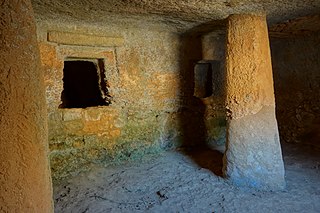
The necropolis of Anghelu Ruju is a pre-Nuragic archaeological site located north of the city of Alghero, Province of Sassari, Sardinia. It is the largest necropolis of pre-Nuragic Sardinia.

The Beaker culture in Sardinia appeared circa 2100 BC during the last phase of the Chalcolithic period. It initially coexisted with and then replaced the previous Monte Claro culture in Sardinia, developing until the ancient Bronze Age circa 1900–1800 BC. Then, the Beaker culture mixed with the related Bonnanaro culture, considered the first stage of the Nuragic civilization.
The San Ciriaco culture, sometimes also called San Ciriaco Phase, is a middle neolithic, pre-Nuragic culture from Sardinia and roughly dates to the second half of the 5th millennium BC. It is named after a locality in the territory of Terralba, in the province of Oristano.

Hampsicora was a Sardo-Punic political leader and landowner of Sardinia, and the leader of the major anti-Roman revolt in the province of 215 BC.

The Bonuighinu culture or Bonu Ighinu culture, sometimes also called Bonu Ighinu Phase, is a middle neolithic, pre-Nuragic culture from Sardinia and roughly dates to the first half of the 5th millennium BC. It takes its name from a locality in the municipality of Mara, province of Sassari, where the cave of Sa de Ucca of Tintirriolu is located. The first Bonu Ighinu pottery was discovered here by Renato Loria and David H. Trump in 1971.

The history of Phoenician and Carthaginian Sardinia deals with two different historical periods between the 9th century BC and the 3rd century BC concerning the peaceful arrival on the island of the first Phoenician merchants and their integration into the Nuragic civilization by bringing new knowledge and technologies, and the subsequent Carthaginian presence aimed at exploiting mineral resources of the Iglesiente and controlling the fertile plains of the Campidano.




